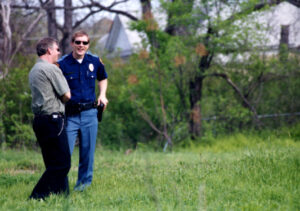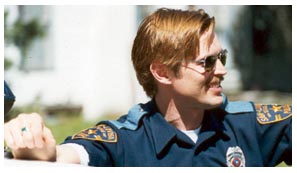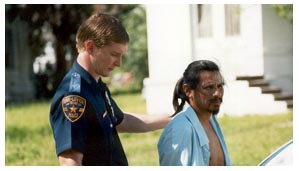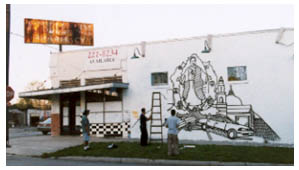
EXT. CARLA & VICTOR’S HOUSE — DAY
Scene #36
EXT. CARLA & VICTOR’S HOUSE — DAY
Scene #40
EXT. CARLA & VICTOR’S HOUSE — DAY
Scene #73
EXT. HIGHWAY — DAY
Scene #104R pt.
EXT. MURAL STREET – MURAL OUTLINE — DUSK
Scene #49 pt.
Day two at Carla & Victor’s house went well. It was all day exterior, which is usually easier than interior scenes, because there’s more room to move and less (if any) lighting. Even day interior scenes can involve considerable lighting, depending on the desired effect. In addition, almost all of the practical interiors we used on EvenHand were cramped, which is never ideal when you have a crew of 20 or more milling around. So, outside is excellent.

Morning enjoys himself
Scene 40 was especially good, because it escalates the conflict between Francis and Morning. Victor, hog-tied and yelling, is safely deposited in the back of the patrol car and Morning waits for Francis to return from a chat with Carla. He goes in with a domestic violence pamphlet and returns to the car to report that she is “fooling around with the knife and laughing it up.” Morning dismisses Francis’ concerns, still unwilling to budge from his assertion that Victor is the problem. The scene ends with an unexpected window into Morning’s human side. It’s brief, but significant.
Before we got to the meat of the scene, we spent about half an hour discussing how Bill S. was going to hog-tie Hector (a scene we would actually film at a later date). We also sought the advice of our set medic, Joe Herlocker, on proper techniques for the Bills to safely carry Hector after his arms and legs were cuffed behind him. Each of these decisions would impact on how the earlier hog-tie scene would be shot.

Victor’s arrested — again
Today was also the day we reshot Francis’ coverage of the scene with the Coach (Sc. 104). We didn’t need to go all the way back to the highway, as the camera angle was more or less from the Coach’s POV, a low angle. At lunch time I drove around and found a vacant lot with an appropriate amount of available sky for the background.
Still, Billy D. had to stand on an apple box and rest his hand on a grip stand (instead of the car). I sat below him on another apple box and recited the Coach’s lines in as near an approximation of Joe Miller’s performance as I could muster. Not the ideal circumstances for an actor — standing in an entirely contrived environment with none of the correct props or actors. Bill also told me later that it was not easy playing to the director, but I couldn’t think of anyone else that I could rely on to recreate the Coach’s reading.
I knew Bill had it in him to nail the moment, but I also expected that because of the nature of the scene it would take several takes for him to get there. There wasn’t anything I could say from a directorial perspective to add to what he already knew, so it became a question of playing the scene and shooting until I felt the emotion. The total count was 10 takes and one pick-up. And he made it to that magical place. If it had taken 20 takes, I would have gone there, but it would have been hard to not think of the expense of all that film (hey — I haven’t whined about the torture of low-budget filmmaking in days!).

Francis talks to the absent Coach
Next on the agenda was a company move to the Mural wall. The shot we needed was one for which we didn’t yet have an actor, Toby, but because of the schedule of painting the mural, we had to shoot the scene anyway. This provided a great opportunity for creative thinking: how do you film a scene without a principal actor? The scene opens on Toby crouched behind a dumpster, trying to saw through his handcuffs. Morning has let him go, but refused to uncuff him. As scripted, we pan from Toby, sawing away, to reveal the kids painting the mural, 1/3 complete.

The mural begins to take shape
My solution was to shoot the mural, dead on, with the kids approaching with ladders and spray cans. Later, when we had Toby on set, we would return to the location at the same time of day with the same kids, the same props and have them repeat their action, only this time, we would shoot them in profile after craning up from Toby behind the dumpster. By this time in the schedule, the mural would be almost completed, so we would frame the shot to exclude the wall. When cut together, there would be no reason to believe that the two shots were not done on the same day.
I lectured everyone about the importance of exactly duplicating the action, props and wardrobe, making sure that numerous polaroids were taken and that Kinya, the script supervisor, took copious notes. A simple yet elegant solution, dependent only on several crew members and extras appreciating the sanctity of continuity. Stay tuned for part II of this story (the March 21st journal entry).
– Joseph Pierson



